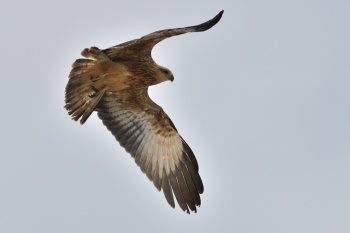(Picture sizes, captions and layout. Additional images Galleried) |
(Imp sizes. Picture of young bird on an early flight) |
||
| Line 2: | Line 2: | ||
;[[:Category:Haliastur|Haliastur]] indus | ;[[:Category:Haliastur|Haliastur]] indus | ||
==Identification== | ==Identification== | ||
| − | + | 44–52 cm (17¼-20½ in) | |
*Chestnut | *Chestnut | ||
*White head and breast | *White head and breast | ||
| Line 18: | Line 18: | ||
====Subspecies==== | ====Subspecies==== | ||
Four subspecies are recognised<sup>[[#References|[1]]]</sup>:<br /> | Four subspecies are recognised<sup>[[#References|[1]]]</sup>:<br /> | ||
| − | + | *''H. i. indus'': | |
| − | ''intermedius'' | + | :*Breeds from [[India]] to [[China]] and [[Indochina]]<br /> |
| − | ''girrenera'' | + | *''H. i. intermedius'': |
| − | ''flavirostris'' | + | :*In [[Malaysia]], the [[Philippines]] and [[Indonesia]]<br /> |
| + | *''H. i. girrenera'': | ||
| + | :*In [[Australia]], [[New Guinea]] and the Bismarck Archipelago<br /> | ||
| + | *''H. i. flavirostris'': | ||
| + | :*In the [[Solomon Islands]] | ||
==Habitat== | ==Habitat== | ||
Coastal mudflats, islands, estuaries and mangroves up to 2,300m. In some areas common in coastal towns. | Coastal mudflats, islands, estuaries and mangroves up to 2,300m. In some areas common in coastal towns. | ||
==Behaviour== | ==Behaviour== | ||
| + | [[Image:Brahminy Kite Juv 00000002.jpg|thumb|350px|right|Juvenile taking an early flight<br />Photo by {{user|Mzungu|Mzungu}}<br />King Island, Wellington Point, Brisbane, [[Queensland]], [[Australia]], Aug 2017]] | ||
====Breeding==== | ====Breeding==== | ||
It nests in mangrove trees, close to water. The nest is made of twigs and sticks, usually lined with dried mud. The 2 white eggs have scattered red-brown blotches. Both adults care for the young. | It nests in mangrove trees, close to water. The nest is made of twigs and sticks, usually lined with dried mud. The 2 white eggs have scattered red-brown blotches. Both adults care for the young. | ||
====Diet==== | ====Diet==== | ||
| − | |||
The diet includes frogs, small snakes, crabs, insects and fish. It also scavenges. | The diet includes frogs, small snakes, crabs, insects and fish. It also scavenges. | ||
====Vocalisation==== | ====Vocalisation==== | ||
| Line 39: | Line 43: | ||
</gallery> | </gallery> | ||
==References== | ==References== | ||
| − | #{{Ref- | + | #{{Ref-Clements6thAug17}}#naturia |
{{ref}} | {{ref}} | ||
==External Links== | ==External Links== | ||
Revision as of 20:13, 27 August 2017
- Haliastur indus
Identification
44–52 cm (17¼-20½ in)
- Chestnut
- White head and breast
- Black wing tips
- Yellow feet
Juveniles are browner
Distribution
Southern Asia to Australia.
Breeds in much of India and Sri Lanka and in mainly coastal areas from Burma and southern China south to Malaya and from the Philippines, Borneo and Sumatra east to New Guinea, the Bismarck Archipelago and Solomon Islands, and Australia. In Australia a northern coastal species found from about Shark Bay in Western Australia to central New South Wales.
Resident.
Taxonomy
Subspecies
Four subspecies are recognised[1]:
- H. i. indus:
- H. i. intermedius:
- In Malaysia, the Philippines and Indonesia
- In Malaysia, the Philippines and Indonesia
- H. i. girrenera:
- In Australia, New Guinea and the Bismarck Archipelago
- In Australia, New Guinea and the Bismarck Archipelago
- H. i. flavirostris:
- In the Solomon Islands
Habitat
Coastal mudflats, islands, estuaries and mangroves up to 2,300m. In some areas common in coastal towns.
Behaviour

Photo by Mzungu
King Island, Wellington Point, Brisbane, Queensland, Australia, Aug 2017
Breeding
It nests in mangrove trees, close to water. The nest is made of twigs and sticks, usually lined with dried mud. The 2 white eggs have scattered red-brown blotches. Both adults care for the young.
Diet
The diet includes frogs, small snakes, crabs, insects and fish. It also scavenges.
Vocalisation
Call: a mewing keeyew, kweeaa or kyeeer.
Gallery
Click on photo for larger image
Nominate Ssp. indus
Photo by Alok Tewari
Gohana, Dist. Sonipat, Haryana, India, January 2017Sub-adult, Subspecies intermedius
Photo by Bobby6425
Philippines
References
- Clements, J. F., T. S. Schulenberg, M. J. Iliff, D. Roberson, T. A. Fredericks, B. L. Sullivan, and C. L. Wood. 2017. The eBird/Clements checklist of birds of the world: v2017, with updates to August 2017. Downloaded from http://www.birds.cornell.edu/clementschecklist/download/
- naturia
Recommended Citation
- BirdForum Opus contributors. (2025) Brahminy Kite. In: BirdForum, the forum for wild birds and birding. Retrieved 10 May 2025 from https://www.birdforum.net/opus/Brahminy_Kite
External Links







